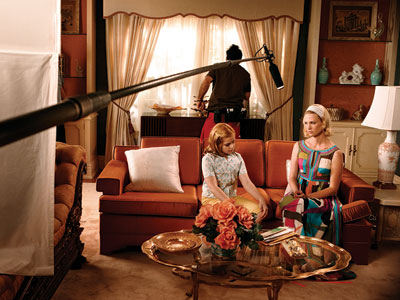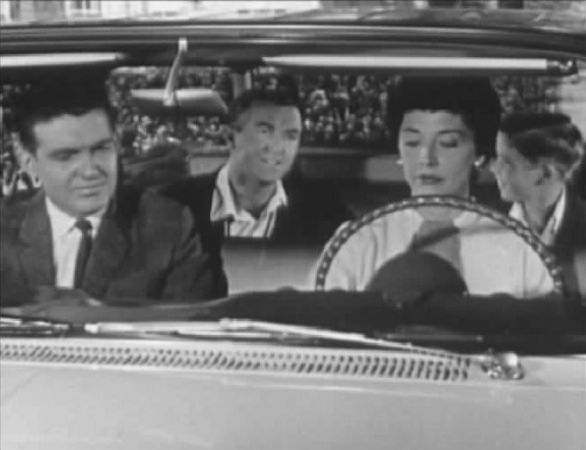Difference between revisions of "Sound (Discussion)"
From Screenpedia
Jump to navigationJump to search (add extra credit option) |
|||
| Line 33: | Line 33: | ||
#'''Each group:''' Think back to the ''Chevrolet'' commercial that we broke down and the shot of Mother, salesman, Father, son in the car. As a group, pretend you're doing ADR (and what is ADR?) and sound mixing for this shot: | #'''Each group:''' Think back to the ''Chevrolet'' commercial that we broke down and the shot of Mother, salesman, Father, son in the car. As a group, pretend you're doing ADR (and what is ADR?) and sound mixing for this shot: | ||
| − | ##Write dialogue and/or specify sound effects that illustrates how sound editors can manipulate '''sound perspective''' to alter our understanding of a scene (somewhat like the sound editor of ''Ugly Betty'' did in [ | + | ##Write dialogue and/or specify sound effects that illustrates how sound editors can manipulate '''sound perspective''' to alter our understanding of a scene (somewhat like the sound editor of ''Ugly Betty'' did in [https://criticalcommons.org/view?m=5sQwk7Xwj the textbook example], but do not copy it). '''Briefly explain how your audio does so.''' |
<!-- | <!-- | ||
##*My audio and sound effects illustrate how sound editors can manipulate sound perspective. It does this because the boy is seen in the background, but his voice is the same volume as the mom's voice. Also, the radio audio should be in the background; however, it is louder than the dialogue. | ##*My audio and sound effects illustrate how sound editors can manipulate sound perspective. It does this because the boy is seen in the background, but his voice is the same volume as the mom's voice. Also, the radio audio should be in the background; however, it is louder than the dialogue. | ||
| Line 40: | Line 40: | ||
##**Radio: (Plays louder than both actors' dialogue.) | ##**Radio: (Plays louder than both actors' dialogue.) | ||
--> | --> | ||
| − | ##Illustrate how sound '''and time''' could be manipulated in this shot, creating new dialogue and/or other audio to lay over the image (as in [ | + | ##Illustrate how sound '''and time''' could be manipulated in this shot, creating new dialogue and/or other audio to lay over the image (as in [https://criticalcommons.org/view?m=qNlBghboU the textbook's example from ''Damages'']). '''Briefly explain how your audio does so.''' |
<!-- | <!-- | ||
##*Dialogue of the salesman talking about the features of the car earlier could be overlaid on the present scene. This would show what the mom is thinking about while they sit in the car. | ##*Dialogue of the salesman talking about the features of the car earlier could be overlaid on the present scene. This would show what the mom is thinking about while they sit in the car. | ||
Revision as of 17:48, 5 October 2020
Purposes of sound on television
Television lists four "purposes of sound on television":
- Capturing viewer attention.
- Manipulating viewer understanding of the image.
- Maintaining television flow.
- Maintaining continuity within individual scenes.
Sound technology
- What are the different types of microphone pick-up patterns? How do they affect sound perspective? (Ugly Betty example.)
Sound exercises
1. Sound-image interaction
A Dodge commercial exercise provides examples of how sound can manipulate viewer understanding of the image--that is, can change its meaning.
- The textbook discusses the impact of Gymnopedie No. 1 and "Solidarity Forever." What do you think is the effect of each of the additional pieces of music available online here.
- Henri’s Notions, "Mrs. Kelly’s Chickens/Louis Waltz"
- Huxford Symphony Orchestra, Tchaikovsky Symphony No. 4
- Jake Berry, "Walking"
- "Movie music": "Invaders from Mars"
- Extra credit (two points):
- Choose a well-known song that, if laid over the commercial, would change its meaning. (No R-rated songs, please.)
- Create a new video that uses the Dodge commercial, but replaces the original sound with this song.
- Upload the video (probably to Blackboard) to share it with the class.
- Write a short explanation of how you feel your song changes the meaning of the commercials images.
2. Sound perspective, time, and the diegesis
- Each group: Think back to the Chevrolet commercial that we broke down and the shot of Mother, salesman, Father, son in the car. As a group, pretend you're doing ADR (and what is ADR?) and sound mixing for this shot:
- Write dialogue and/or specify sound effects that illustrates how sound editors can manipulate sound perspective to alter our understanding of a scene (somewhat like the sound editor of Ugly Betty did in the textbook example, but do not copy it). Briefly explain how your audio does so.
- Illustrate how sound and time could be manipulated in this shot, creating new dialogue and/or other audio to lay over the image (as in the textbook's example from Damages). Briefly explain how your audio does so.
- Finally, describe new audio for the scene that illustrates the difference between diegetic vs. nondiegetic sound. Briefly explain how your audio does so.
- One person from each group must write the group's responses in Blackboard in the survey titled, "Sound perspective, time, and the diegesis," in the Assignments folder.
- I will select the responses that best exemplify these sound-image principles and post them here. If I select a response from your group, then everyone in that group (who was not absent) will earn one extra credit point.
- Responses must be submitted by 11:59 p.m. tomorrow (10/4) to qualify for extra credit.
Types of sound
- What are the three main types of sound in TV production and how do digital audio workstations mirror those three types? (See Ugly Betty ProTools layout for music editor.)
- What is "public domain" music? What are "master rights"? How do master rights apply to DVD releases of TV programs?
Bibliography
- Butler, Jeremy G. Television: Visual Storytelling and Screen Culture. New York: Routledge, 2018.

